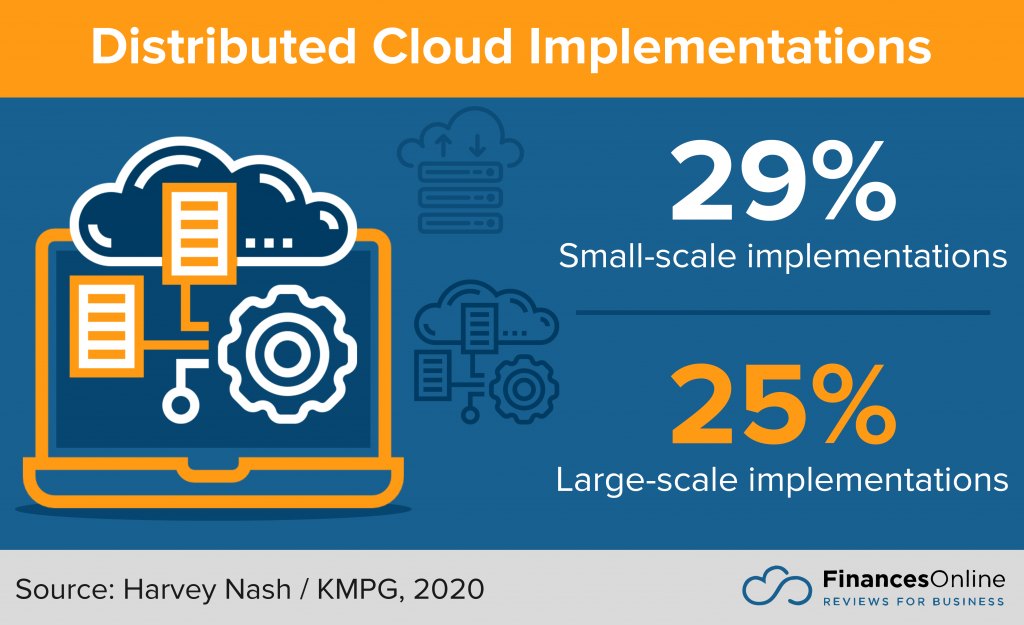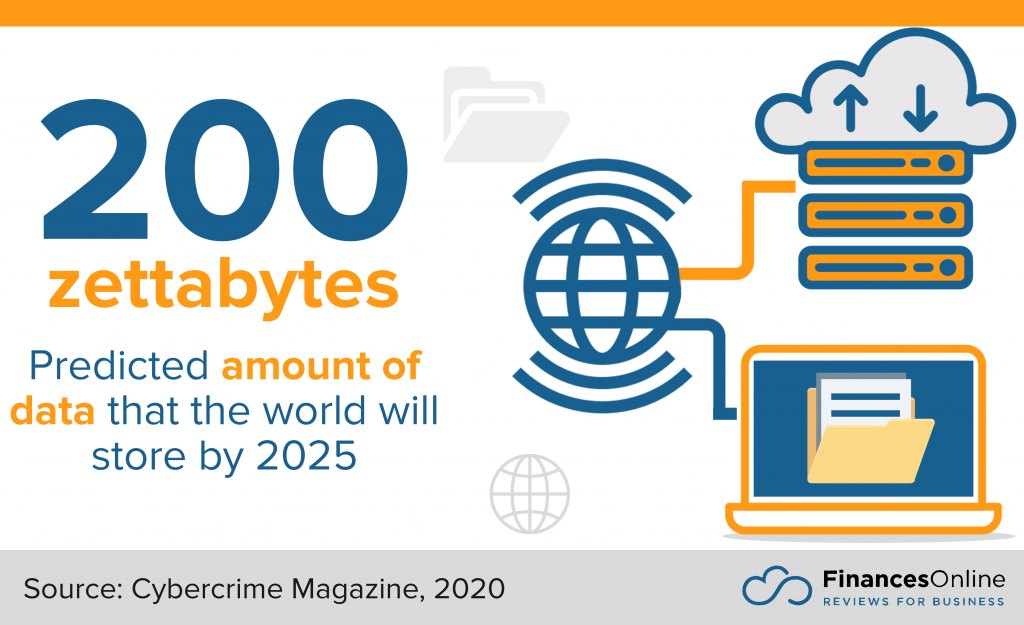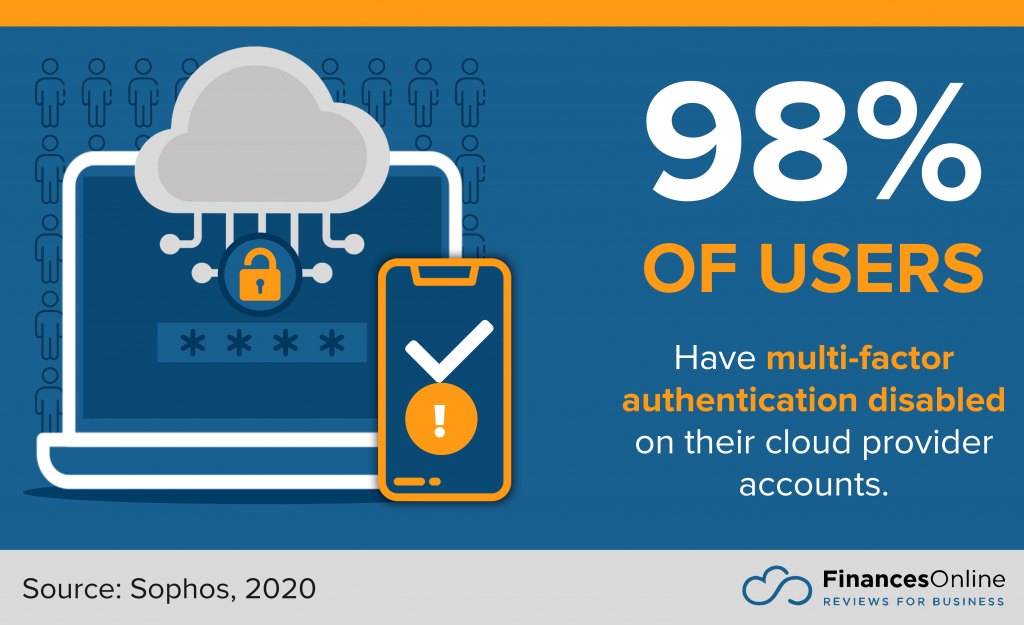Workers used to spend a lot of time printing, copying, filing, and searching for documents. However, now that companies have transitioned to remote work, much of those activities are being done on the cloud. With the help of document management software as well as file sharing software, organizations can digitize paper-based processes so they can save time and money associated with looking for files.
In this article, we outline the relevant cloud file and document management software statistics for 2022 that show where the industry is heading. Individuals and businesses alike can look at various data points, from market data to document management software adoption to digitization challenges. In this way, you can have evidence-based data in switching to the cloud and anticipate possible barriers to adopting a digital document management strategy.

Cloud File & Document Management Software Statistics Table of Contents
State of Document Management Migration Statistics
Much hype has been made about transitioning to a paperless environment. However, data shows that paper is not going away anytime soon. Experts predict that even as the number of pages printed worldwide declines, there’s still a considerable amount of paper being generated for purposes other than newspapers, magazines, and the like. On the other hand, cloud file and document management software statistics show that organizations are moving towards digital processes. However, the majority still use paper in tandem with digital tools. Moreover, a considerable number of businesses are moving their data to the cloud despite the challenges it poses. With this, document management industry statistics paint a positive outlook with anticipated double-digit growth in the next few years.
Digital Document Management Adoption
- 62% of IT decision-makers say that sales departments are using digital documentation tools. Other top departments mentioned were marketing (57%), finance (53%), and IT (41%) (Forrester, 2020).
- 47% of IT decision-makers say that their organizations use digital document processes (Forrester, 2020).
- 72% of IT decision-makers say that their organization uses a combination of paper and digital processes. 13% say that they use digital processes exclusively (Forrester, 2020).
- 61% of IT decision-makers said that migrating to the cloud is an important initiative in elevating their organization’s digital maturity (Forrester, 2020).
- 36% of IT decision-makers say that they are expanding or upgrading the implementation of digital document process solutions over the next 12 months. Meanwhile, 35% said that they have implemented but will not be expanding or upgrading these technologies (Forrester, 2020).
- 71% of IT decision-makers who come from companies that do not consider digitizing document workflows as a “standard protocol” say that this attitude is changing (Forrester, 2020).
- In 2020, there were 2.8 trillion pages printed worldwide, which went down by 14% year over year after declining slowly but steadily after several years (IDC, 2021).
- In 2020, 50% of printing done at home was for work purposes, 18% for school or educational purposes, and 32% for personal purposes (IDC, 2021).
- By 2025, experts predict that there will be 2.3 trillion pages printed. Despite the decline in printing, this figure still represents 4.4 million pages printed around the world every minute which is equivalent to 39 football fields (IDC, 2021).
- 23% of registered investment advisors said that they are investing in digital document and e-signature tools (TD Ameritrade, 2020).
State of Processes in Organizations 2020
Source: Forrester, 2020
Designed byCloud Migration Statistics
- 52% of organizations are moving or considering moving their databases to the cloud for analytics. Other top reasons given were moving to a SaaS model (47%) and modernizing existing apps (46%) (DZone, 2020).
- The top cloud migration challenges for enterprises are understanding app deficiencies (51%), assessing technical feasibility (49%), and assessing on-premise versus cloud costs. On the other hand, the top concerns for small and medium businesses were understanding app deficiencies (52%), optimizing post-migration costs (44%), and right-sizing or selecting the best instance (43%) (Flexera, 2021).
- The top three cloud challenges for both enterprises and SMEs are security (81%), managing cloud spend (79%), and governance (75%). Other challenges cited were lack of resources or expertise (75%), compliance (75%), and managing bring your own license (BYOL) models (Flexera, 2021).
- In 2020, 42% of organizations said that their storage, archive, backup, and file server are currently being migrated or deployed in the cloud. Meanwhile, 17% plan to migrate these apps and services in the next 12 months, and 15% plan to do so in the next one or three years (IDG, 2020).
- 26% of global organizations have applications that were ported and/or migrated from one public cloud Infrastructure as a service (IaaS) to another (Seagate, 2020).
- 46% of organizations said that they used data migration, tiering, or replacement to manage data (Seagate, 2020).
- Around 50% of businesses in Europe are progressing into a cloud-first strategy. Meanwhile, 70% are migrating more workloads to the cloud and 59% are optimizing existing use of the cloud (Flexera, 2021).

Document Management Global Market Statistics
- As of October 2021, there are a total of 4.88 billion global internet users. There was an increase of 222 million users or a 4.8% annual change in the number of global internet users (We are Social / Hootsuite, 2021).
- By 2023, there will be 5.3 billion internet users around the world (Statista, 2021).
- In 2020, the global enterprise file synchronization and sharing market was worth $5.29 billion. This is expected to reach $21.27 billion by 2026, at a CAGR of 26.3% from 2021 to 2026 (Mordor Intelligence, 2020).
- The global document management system market is forecast to reach $11.47 billion by 2026. From 2020 to 2026, it will register a CAGR of 13.05% (Mordor Intelligence, 2021).
- The industry revenue of document preparation services in the US is estimated to reach $4.64 billion in 2024 (Statista, 2020).
- In 2020, the collaboration applications market was estimated to be worth $16 billion. It is expected to reach $17.9 billion by 2025, at a CAGR of 2.3% (Apps Run the World, 2021).
- The cloud management and security services segment is expected to grow by 17.3% in 2022. The public cloud services market is projected to grow by 18.8% (Statista, 2021).
Cloud File and Document Management Software Statistics
Businesses are investing in cloud file and document management software, with sales departments registering the highest usage of digital tools. When it comes to execution, roughly a third of distributed cloud implementations are small-scale while one-fourth are large-scale. Large-scale implementations are expectedly higher for digital leaders. Usage of cloud management software is likewise expected to grow higher, thanks in part to the pandemic-driven shift to remote work. As a result of this, more bytes of data will be stored in the cloud.
Current State of Cloud File and Document Management
- 35% of CIOs said that infrastructure or cloud technologies are among their top three most important technology investments (Harvey Nash / KMPG, 2020).
- 29% of distributed cloud technology implementations are small scale while 25% are large-scale (Harvey Nash / KMPG, 2020).
- Usage of distributed cloud technologies changed by 53% during the COVID phase of 2020 compared to a 50% change during the pre-COVID phase of 2020 (Harvey Nash / KMPG, 2020).
- 42% of digital leaders have large-scale implementations of distributed cloud technologies (Harvey Nash / KMPG, 2020).
- 19% of CIOs say that infrastructure and cloud technologies are areas that attract the most business-managed IT investment (Harvey Nash / KMPG, 2020).
- 27% of the cybersecurity budget of organizations is allocated to cloud security (Netwrix, 2021).
- 26% of organizations with a cloud database solution had them in place for three to four years. Meanwhile, 21% had them in place for more than five years (DZone, 2020).
- In 2020, 54% of organizations had mostly on-premise software deployment with some cloud services on the side. Only 9% have cloud-only environments. In 2021, only 36% of businesses are expected to stay this way. Around 43% will likely have a mostly-cloud deployment while 16% of businesses will have an all-cloud deployment. (IDG, 2020)
- 29% of large enterprises and 34% of SMBs said they used significantly higher cloud usage services than planned because of COVID-19. (Flexera, 2021)
- 62% of sales departments used digital documentation tools in 2020. Such tools were also in use at 57% of marketing departments, 53% of finance departments, and 41% of IT departments (Forrester, 2021).
Departments that Use Digital Documentation Tools (2020)
Sales Department: 62
Sales Department
%Marketing Department: 57
Marketing Department
%Finance Department: 53
Finance Department
%IT Department: 41
IT Department
%Source: Forrester, 2021
Designed byCloud File and Document Management Outlook and Predictions
- The current organizational spending on the public cloud is, on average, 24% over budget. In the next 12 months, experts predict a 39% growth over current spending (Flexera, 2021).
- By 2025, the world will have to store over 200 zettabytes of data, including those stored in public and private IT infrastructures and cloud centers as well as personal computing devices. (Cybercrime Magazine, 2020)
- In 2020, there were a total of 221 terabytes in cloud repositories. In 2022, this is expected to grow to 498 terabytes or at 42.2% (Seagate, 2020).
- 51% of organizations use an enterprise private cloud as part of their IT infrastructure. On the other hand, 50% use a public cloud, 37% use multi-cloud, and another 37% use a hybrid cloud (Seagate, 2020).
- In 2020, 30% of data was stored in internally managed enterprise data centers. In 2022, this is expected to decrease to 28%. On the other hand, 22% of data was stored in cloud repositories, which is expected to increase to 25% in 2022 (Seagate, 2020).

Benefits of Cloud File and Document Management Statistics
There are a host of benefits to storing documents on the cloud. However, cloud file and document management statistics 2022 show that increased productivity and efficiency is the reason that resonates the most to users across various surveys. These tools also helped businesses overcome the challenges brought about by the pandemic, making it an important part of an organization’s business continuity plans.
- 72% of IT decision-makers said that digital document processes allow their organizations to better maintain business continuity despite unforeseen circumstances (Forrester, 2020).
- 47% of IT decision-makers stated that digital document processes enable them to pursue opportunities and gain new customers during the pandemic (Forrester, 2020).
- 40% of IT decision-makers associate increased customer satisfaction and increased employee productivity during the pandemic with digital document processes (Forrester, 2020).
- 55% of IT decision-makers said that one of the most important benefits of digital document processes and tools in light of the pandemic was accelerating document processing (Forrester, 2020).
- IT decision-makers from organizations with no digital document process say that they have 10 times more at-risk customers and two times more at-risk revenue than those of other companies (Forrester, 2020).
- 41% of organizations that are currently using cloud databases have realized improved speed-to-market. In addition, 31% said they have realized improved data security, 28% noted improved efficiency, and 30% enjoyed the ease of access (DZone, 2020).
- 54% of organizations worldwide are motivated to use software as a service (SaaS) solutions to increase productivity. Other reasons given were to reduce costs (35%), increase security (27%), and improve the employee experience (23%) (BetterCloud, 2020).
- 31% of organizations believe that collaboration tools have made them more efficient than before. Meanwhile, 35% said that they have experienced setbacks, but have seen improvement in the long run (Lenovo, 2021).
Reasons Why Organizations Will Use More SaaS
Increase productivity: 54%
Increase productivity
54%Reduce costs: 35%
Reduce costs
35%Increase security: 27%
Increase security
27%Improve employee experience: 23%
Improve employee experience
23%Speed up app deploymen: 18%
Speed up app deploymen
18%Enable a remote workplace: 16%
Enable a remote workplace
16%Grow revenues: 10%
Grow revenues
10%Enter new markets: 3%
Enter new markets
3%Attract and retain the best talent: 3%
Attract and retain the best talent
3%Source: BetterCloud, 2020
Designed byMost Popular Document Management Software
- PandaDoc. This comprehensive online document management solution is a top choice for large or small businesses, even among individual users. You can read more about it in our PandaDoc review.
- Backlog. A document management software that can address the needs of developers as well as non-tech-savvy users. Refer to this Backlog review for more information.
- eFileCabinet. A secure document management solution designed to help businesses reduce and even eliminate traditional paper-based processes. Our eFileCabinet review discusses its key features and other important details.
- Templafy. Robust, customizable document management solution designed to support the branding needs of businesses. Read more about this award-winning solution in our Templafy review.
- Samepage. A feature-packed document management platform for teams that require an extensive array of collaboration tools. For more details, check this Samepage review.
Online File Sharing Statistics
File sharing and e-signature software are important aspects of an organization’s digital collaboration toolkit. Today, most of a company’s sensitive data is stored in the cloud. This has led cybercriminals to target such data through malware, ransomware, and other malicious attacks. To combat this, users should be vigilant of file-sharing settings while organizations need to beef up their controls around user access and authentication.
Document Sharing Statistics
- 72% of IT decision-makers said that document sharing is one of the most important features of digital document processes and tools in supporting their organization’s business continuity and agility (Forrester, 2020).
- 60% of IT and security professionals think that end-users should be more attentive to file-sharing settings (BetterCloud, 2020).
- 81% of sensitive data live in cloud storage applications like Google Drive. On the other hand, 80% reside in emails while 70% are stored in devices such as laptops, mobile devices, and whiteboards (BetterCloud, 2020).
- 54% of IT and security professionals report having a less-than-positive outlook when it comes to trusting users to share company data responsibly (BetterCloud, 2020).
- 91% of organizations give excess access permissions to Identity and Access Management roles. On the other hand, 98% had multi-factor authentication disabled on their cloud provider accounts (Sophos, 2020).

Cloud Security Breach Statistics
- 55% of data theft involving files that were not classified were discovered in days or weeks while 58% of data theft involving classified files were discovered within minutes or hours (Netwrix, 2021).
- 62% of medium-sized organizations say that an understaffed IT/security team was their biggest cloud security challenge (Netwrix, 2021). Other reasons cited for this organization size were lack of budget (48%), lack of cloud security expertise (41%), and employee negligence (33%) (Netwrix, 2021).
- 52% of organizations cited an understaffed IT/security team as their top challenge in cloud data security. Other top reasons were lack of budget (47%), lack of expertise in cloud security (44%), and employee negligence (38%) (Netwrix, 2021).
- In 2020, 7 out of 10 organizations suffered a public cloud security breach (Sophos, 2020).
- 95% of organizations expressed concerns about their current state of cloud security (Sophos, 2020).
- Malware accounted for 34% of security incidents in organizations in 2020. This is followed by exposed data (28%), ransomware (28%), account compromise (25%), and crypto-jacking (17%) (Sophos, 2020).
- 93% of organizations in India reported a public cloud security incident in the last year. This was followed by Nigeria (86%) and the Philippines (82%) (Sophos, 2020).
- Countries in Europe reported the lowest rates of public cloud security incidents in 2020. These include Italy (45%), Poland (47%), Spain (57%), the United Kingdom (61%), and Germany (61%) (Sophos, 2020).
- The top cloud security concerns for organizations worldwide were data loss or leakage (44%), identifying and responding to security incidents (41%), and managing multiple public cloud providers (28%) (Sophos, 2020).
- 59% of ransomware attacks involved data in the public cloud. On the other hand, 41% involved data on-premises or private cloud data (Sophos, 2020).
Source: Sophos, 2020
eSignature Statistics
- In 2020, the global market for digital signatures was worth $2.17 billion. By 2025, it is forecast to reach $6.9 billion at a CAGR of 27% (Research and Markets, 2021).
- In a survey, 61% of respondents strongly agreed that it is more convenient to sign e-documents from home (Adobe, 2021).
- The top three benefits of using e-signatures were convenience (73%), reduction of paper waste (48%), and speed (45%) (Adobe, 2021).
- In a survey, 34% of respondents said that they rely solely on digital storage for important documents. Meanwhile, 36% store documents both digitally and physically (Adobe, 2021).
- 50% of survey respondents said that they signed a document electronically in the past two years (Adobe, 2021).
- 51% of first-time e-signers said that they had never been offered this option previously while 43% said they did not know it was available. Other reasons given were preference for physically signing documents (23%), opinion that e-signatures are not legally binding (21%), an incompatible device or browser (21%), and thinking that e-signatures are not secure (19%) (Adobe, 2021).
- The top three challenges to using e-signatures are incompatibility between the form and the device, browser, or software (38%); signature not saving in the correct line or place in the document (36%); and the inability to correct or initial errors in the document (26%) (Adobe, 2021).
- 81% of business owners and 71% of individuals in the US said they will opt to use e-signatures than signing documents in person even after the situation comes back to normal from the pandemic-related lockdowns (airSlate, 2021).
- 47% of organizations that adopted e-signature and digital workflows reported gaining new customers during the pandemic (airSlate, 2021).
Benefits of Using eSignatures
Convenience: 73
Convenience
%Reduction of Paper Waste: 48
Reduction of Paper Waste
%Speed: 45
Speed
%Source: Adobe, 2021
Designed byData on the Challenges of Digitizing Document Management
There is a misconception that the digital transformation of an organization’s document management processes solves all of its woes. While it does accelerate previously paper-based processes, it also creates a host of other challenges such as ensuring proper security controls, compliance with relevant laws, transferring all data to the cloud, and managing multi-cloud environments. User satisfaction and working with non-integrated apps that impact team collaboration can also hinder user adoption of these tools.
- 59% of organizations that are not using a cloud database management system (DBMS) said their biggest challenge to migrating to a DMBS is adhering to data privacy laws and regulations. (DZone, 2020).
- 24% of organizations said that it will take more than five years before all their data is stored in a cloud DBMS (DZone, 2020).
- The average satisfaction rating for digital collaboration is 6.5 out of 10 (Gmelius, 2021).
- The top three challenges that are stopping efficient collaboration in an organization’s digital workplace are fake urgency (45%), lack of visibility (42%), and cross-team collaboration (39%) (Gmelius, 2021).
- 75% of knowledge workers agree that the excess of non-integrated apps is hampering their team’s productivity (Gmelius, 2021).
- 68% of teams spend most of their time on emails more than messaging and video apps. However, only 20% of teams like to collaborate internally over email (Gmelius, 2021).
- 58% of decision-makers in the UK said that ensuring cybersecurity is the biggest barrier to public cloud adoption in their organizations (Centrify, 2021).
- 36% of organizations said that managing data in multi-cloud environments was challenging. On the other hand, 33% said the same about managing data in hybrid-cloud environments (Seagate, 2020).
Source: Seagate, 2020
Making the Switch to Cloud Document Management
If the cloud file and document management software statistics above are of any gauge, for all the predictions that have been made about working in a paperless environment, organizations today still use a combination of paper and digital processes. The good news is that they are making the switch to operating in the cloud, albeit not at full speed to an all-cloud model. It is true that there is a strong multi-billion dollar market for such products. However, organizations do have to contend with security and user adoption issues before they can implement them in their environment.
In the next few years, experts predict that more data will be stored in the cloud, paving the way for the need for file management technologies. As the market matures, it is expected that businesses will realize the benefits of using document management software. As such, they will most likely invest in such tools or maximize their use within their organization.
References:
- Adobe. (2021 January). Document Cloud E-Signature Survey: APAC Topline Results. Adobe.
- airSlate. (2021, May 19). airSlate looked into how individuals and US businesses are using eSignature during COVID-19. airSlate.
- BetterCloud. (2020). 2020 State of SaaSOps: The Impact and Implications of the SaaS Revolution. BetterCloud.
- Centrify. (2021, January 21). Over half of UK businesses cite security concerns as biggest barrier to public cloud adoption. Centrify.
- DZone. (2020, February 26). Cloud Database Trend Report. DZone.
- Flexera. (2021). Flexera 2021 State of the Cloud Report. Flexera.
- Forrester. (2020). How Digital Processes are Shifting from Best Practice to Business Necessity. Forrester.
- Gmelius. (2021). The State of Digital Collaboration in 2021. Gmelius.
- Harvey Nash / KPMG. (2020). Harvey Nash / KPMG CIO Survey 2020: Everything changed. Or did it?. KPMG.
- IDC. (2021, August 3). IDC Forecasts Worldwide Page Volumes to Rebound In 2021, But Will Not Reach Pre-COVID-19 Levels. IDC.
- IDG. (2020). Executive Summary: 2020 IDG Cloud Computing Survey. IDG.
- Lenovo. (2021 March). The Future of Work and Digital Transformation. Lenovo.
- Mlitz, K. (2021, November 24). Public cloud services growth worldwide 2019-2022, by segment. Statista.
- Mordor Intelligence. (2020). Enterprise File Synchronization And Sharing (Efss) Market – Growth, Trends, Covid-19 Impact, And Forecasts (2021 – 2026). Mordor Intelligence.
- Mordor Intelligence. (2021). Document Management Systems Market – Growth, Trends, Covid-19 Impact, And Forecasts (2021 – 2026). Mordor Intelligence.
- Morgan, S. (2020, June 20). The World Will Store 200 Zettabytes Of Data By 2025. Cybercrime Magazine.
- Netwrix. (2021). 2021 Cloud Data Security Report. Netwrix.
- O’Dea, S. (2021, January 18). Global internet user growth 2018-2023. Statista.
- Pang, A., Markovski, M., and Trifunovski, M. (2021, December 21). Top 10 Collaboration Software Vendors, Market Size and Market Forecast 2020-2025. Apps Run the World.
- Research and Markets. (2021, December 10). Global Digital Signature Market Report 2021: Market is Expected to Reach $6.9 Billion in 2025 at a CAGR of 27% – Long-term Forecast to 2030. GlobeNewswire.
- Seagate. (2020). Rethink Data: Put More of Your Business Data to Work—From Edge to Cloud. Seagate.
- Sophos. (2020). The State of Cloud Security 2020. Sophos.
- Statista Research Department. (2021, September 30). Industry revenue of “document preparation services“ in the U.S. 2012-2024. Statista.
- TD Ameritrade. (2020, January 7). TD Ameritrade Institutional: 2020 RIA Sentiment Survey. TD Ameritrade.























Leave a comment!